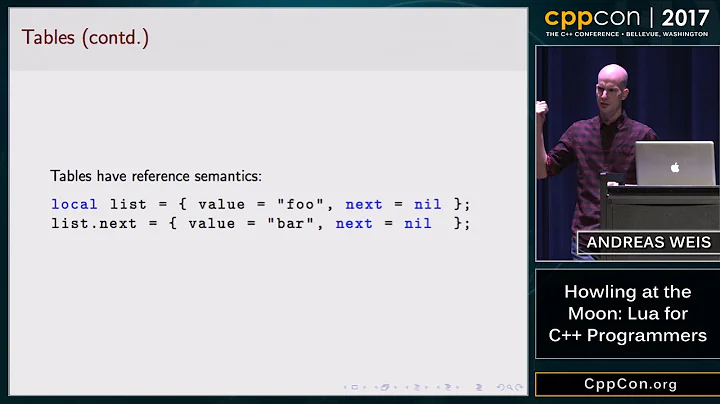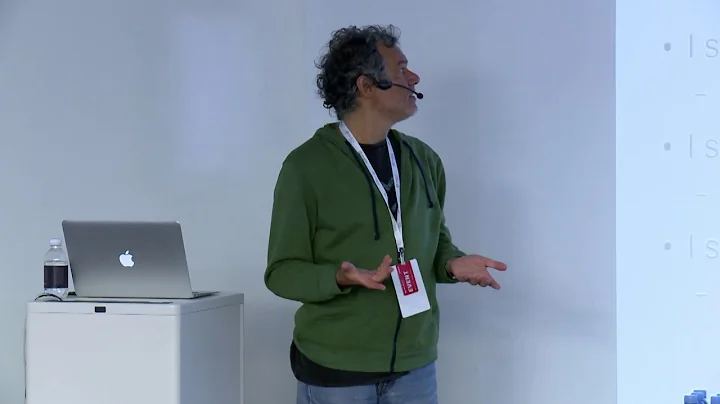Why does Lua have no "continue" statement?
Solution 1
In Lua 5.2 the best workaround is to use goto:
-- prints odd numbers in [|1,10|]
for i=1,10 do
if i % 2 == 0 then goto continue end
print(i)
::continue::
end
This is supported in LuaJIT since version 2.0.1
Solution 2
The way that the language manages lexical scope creates issues with including both goto and continue. For example,
local a=0
repeat
if f() then
a=1 --change outer a
end
local a=f() -- inner a
until a==0 -- test inner a
The declaration of local a inside the loop body masks the outer variable named a, and the scope of that local extends across the condition of the until statement so the condition is testing the innermost a.
If continue existed, it would have to be restricted semantically to be only valid after all of the variables used in the condition have come into scope. This is a difficult condition to document to the user and enforce in the compiler. Various proposals around this issue have been discussed, including the simple answer of disallowing continue with the repeat ... until style of loop. So far, none have had a sufficiently compelling use case to get them included in the language.
The work around is generally to invert the condition that would cause a continue to be executed, and collect the rest of the loop body under that condition. So, the following loop
-- not valid Lua 5.1 (or 5.2)
for k,v in pairs(t) do
if isstring(k) then continue end
-- do something to t[k] when k is not a string
end
could be written
-- valid Lua 5.1 (or 5.2)
for k,v in pairs(t) do
if not isstring(k) then
-- do something to t[k] when k is not a string
end
end
It is clear enough, and usually not a burden unless you have a series of elaborate culls that control the loop operation.
Solution 3
You can wrap loop body in additional repeat until true and then use do break end inside for effect of continue. Naturally, you'll need to set up additional flags if you also intend to really break out of loop as well.
This will loop 5 times, printing 1, 2, and 3 each time.
for idx = 1, 5 do
repeat
print(1)
print(2)
print(3)
do break end -- goes to next iteration of for
print(4)
print(5)
until true
end
This construction even translates to literal one opcode JMP in Lua bytecode!
$ luac -l continue.lua
main <continue.lua:0,0> (22 instructions, 88 bytes at 0x23c9530)
0+ params, 6 slots, 0 upvalues, 4 locals, 6 constants, 0 functions
1 [1] LOADK 0 -1 ; 1
2 [1] LOADK 1 -2 ; 3
3 [1] LOADK 2 -1 ; 1
4 [1] FORPREP 0 16 ; to 21
5 [3] GETGLOBAL 4 -3 ; print
6 [3] LOADK 5 -1 ; 1
7 [3] CALL 4 2 1
8 [4] GETGLOBAL 4 -3 ; print
9 [4] LOADK 5 -4 ; 2
10 [4] CALL 4 2 1
11 [5] GETGLOBAL 4 -3 ; print
12 [5] LOADK 5 -2 ; 3
13 [5] CALL 4 2 1
14 [6] JMP 6 ; to 21 -- Here it is! If you remove do break end from code, result will only differ by this single line.
15 [7] GETGLOBAL 4 -3 ; print
16 [7] LOADK 5 -5 ; 4
17 [7] CALL 4 2 1
18 [8] GETGLOBAL 4 -3 ; print
19 [8] LOADK 5 -6 ; 5
20 [8] CALL 4 2 1
21 [1] FORLOOP 0 -17 ; to 5
22 [10] RETURN 0 1
Solution 4
Straight from the designer of Lua himself:
Our main concern with "continue" is that there are several other control structures that (in our view) are more or less as important as "continue" and may even replace it. (E.g., break with labels [as in Java] or even a more generic goto.) "continue" does not seem more special than other control-structure mechanisms, except that it is present in more languages. (Perl actually has two "continue" statements, "next" and "redo". Both are useful.)
Solution 5
The first part is answered in the FAQ as slain pointed out.
As for a workaround, you can wrap the body of the loop in a function and return early from that, e.g.
-- Print the odd numbers from 1 to 99
for a = 1, 99 do
(function()
if a % 2 == 0 then
return
end
print(a)
end)()
end
Or if you want both break and continue functionality, have the local function perform the test, e.g.
local a = 1
while (function()
if a > 99 then
return false; -- break
end
if a % 2 == 0 then
return true; -- continue
end
print(a)
return true; -- continue
end)() do
a = a + 1
end
Related videos on Youtube
Dant
Updated on July 08, 2022Comments
-
Dant almost 2 years
I have been dealing a lot with Lua in the past few months, and I really like most of the features but I'm still missing something among those:
- Why is there no
continue? - What workarounds are there for it?
-
 lhf over 11 yearsSince this question was asked, Lua got a
lhf over 11 yearsSince this question was asked, Lua got agotostatement which can be used to implement continue. See the answers below.
- Why is there no
-
ubershmekel over 11 yearsComing from a python background this is a confusing answer because every scope there already knows what are its local variables before running. I.e. I expected an unbound local variable error in the case of reaching
until.... -
RBerteig over 11 yearsI know next to nothing about Python. Lua takes a very narrow view of scope for local variables: it is controlled lexically. The scope is limited at the end of the block containing the variable. The quirk is that the condition of the
unlessclause is inside the block lexically, because it makes the usual cases clearest. The example above with a local variableashadowing a global variableashows a case where that invisible lexical boundary can be confusing. Lua 5.2 introducesgoto, but requires that it not be used in a way that would break lexical scoping. -
udoprog over 11 yearsI think you make a fair point, but when you state "If continue existed, it would have to be restricted semantically to be only valid after all of the variables used in the condition have come into scope". Could you explain why this must be enforced? I don't see why a lookup on "inner a" simply could not result in null as any other "non-defined" symbol in the current scope (which is what I expected).
-
RBerteig over 11 yearsThere was a lot of discussion of this in the Lua community before the introduction of
gotointo Lua 5.2. Naturally,gotohas the same issue. They eventually decided that whatever the runtime and/or code generation costs were to protect against it were worth the benefits of having a flexiblegotothat can be used to emulate bothcontinueand multi-levelbreak. You'd have to search the Lua list archives for the relevant threads to get the details. Since they did introducegoto, it obviously was not insurmountable. -
Oleg V. Volkov over 11 yearsPlease don't. You create closure environment on each iteration and this is HUGE waste of memory and GC cycles.
-
Oleg V. Volkov over 11 yearsgo check
collectgarbage("count")even after your simple 100 tries and then we'll talk. Such "premature" optimization saved one highload project from rebooting every minute last week. -
Saurabh over 11 years@OlegV.Volkov while this example does put a relatively high load on the GC, it does not leak - All the temporary closures will be collected. I don't know about your project but IME most repeating reboots are due to leaks.
-
E. T. over 10 yearsI hope they include an actual
continueone day. Thegotoreplacement doesn't look very nice and needs more lines. Also, wouldn't that create trouble if you had more than one loop doing this in one function, both with::continue::? Making up a name per loop doesn't sound like a decent thing to do. -
E. T. over 9 yearsThis answer is nice, but still requires 3 lines instead of just one. (if "continue" was properly supported) It's a bit prettier and safer than a goto label though, since for that name clashes might need to be avoided for nested loops.
-
Shaun Wilson almost 9 yearsit does, however, avoid the "real" problem with goto in that you don't have to invent a new identifier/label for each psuedo-continue and that it is less error prone as code is modified over time. i agree that continue would be useful, but this IMO is the next best thing (and it really requires two lines for the repeat/until vs. a more formal "continue;".. and even then, if you were that concerned with line counts you could always write "do repeat" and "until true end", for example: gist.github.com/wilson0x4d/f8410719033d1e0ef771)
-
Glenn Maynard over 8 yearsThere's nothing "clear enough" about writing code without continue. It's a novice mistake to nest code inside a conditional where a continue should have been used, and the need to write ugly code like that shouldn't receive any sympathy. There's absolutely no excuse.
-
Glenn Maynard over 8 years(Least of all by "no compelling use cases". If they don't understand the importance of continue, they have no place designing a language.)
-
Oleg V. Volkov about 8 yearsThis explanation makes no sense.
localis compiler-only directive - it doesn't matter what runtime insructions are betweenlocaland variable usage - you don't need to change anything in compiler to maintain same scoping behavior. Yes, this might be not so obvious and need some additional documentation, but, to reiterate again, it requires ZERO changes in compiler.repeat do break end until trueexample in my answer already generates exactly the same bytecode that compiler would with continue, the only difference is that withcontinueyou wouldn't need ugly extra syntax to use it. -
Pedro Gimeno almost 8 yearsThat you can test the inner variable speaks about flawed design. The condition is outside the inner scope and it should not have access to the variables within it. Consider the equivalent in C:
do{int i=0;}while (i == 0);fails, or in C++:do int i=0;while (i==0);also fails ("was not declared in this scope"). Too late to change that now in Lua, unfortunately. -
 David Ljung Madison Stellar over 6 yearsI love the admittance: "Both are useful" right after an explanation of "we're not going to do it"
David Ljung Madison Stellar over 6 yearsI love the admittance: "Both are useful" right after an explanation of "we're not going to do it" -
user3479901 over 6 yearsIt was to note the scope that they were looking to address when they did do it, by adding a "goto" construct in 5.2 (which hadn't been released when this answer was written). See this answer from 2012, after 5.2.0 was released.
-
 David Ljung Madison Stellar over 6 yearsRight - because 'goto' is well-recognized to be a decent programming construct. (end sarcasm) Ah well.
David Ljung Madison Stellar over 6 yearsRight - because 'goto' is well-recognized to be a decent programming construct. (end sarcasm) Ah well. -
 neoedmund about 6 yearsBut it did not sound more reasonable than "I just forgot to put
neoedmund about 6 yearsBut it did not sound more reasonable than "I just forgot to putcontinueinto Lua, sorry." -
axkibe almost 6 yearswhile this is true by itself, this is historically incorrect. 'continue' was not added because it would conflict with an existing 'goto' implementation. On the contrary, the wish for continue was continuously uttered to the Lua dev team, until they decided they add goto, because reasons, and thus shut up the 'continue' requests...
-
 Leslie Krause over 5 yearsThe problem with inversion is that more often than not there are multiple conditionals in a series (such as to validate user input). And because there might need to be a short circuit at any point along the way, inversion means having to nest the conditionals continuously (instead of "is this bad? then escape; else is this bad? then escape", which is very straightforward, you end up with code like "is this okay? then is this okay? then is this okay? then do this" which is very excessive.
Leslie Krause over 5 yearsThe problem with inversion is that more often than not there are multiple conditionals in a series (such as to validate user input). And because there might need to be a short circuit at any point along the way, inversion means having to nest the conditionals continuously (instead of "is this bad? then escape; else is this bad? then escape", which is very straightforward, you end up with code like "is this okay? then is this okay? then is this okay? then do this" which is very excessive. -
bfontaine over 4 yearsI downvoted because the very first sentence is obviously false, and the rest of the answer is unhelpful.
-
DarkWiiPlayer over 4 yearsUnhelpful? Maybe; it's a somewhat opinion-based answer. The first sentence is obviously true though;
continuemight be a convenient feature, but that doesn't make it necessary. Lots of people use Lua just fine without it, so there's really no case for it being anything else than a neat feature that's not essential to any programming Language. -
bfontaine over 4 yearsThat’s not an argument: you can’t argue that people are "fine without it" when they don’t have any choice.
-
DarkWiiPlayer over 4 yearsI think we just have different definitions of "necessary" then.
-
DarkWiiPlayer over 4 yearsNice to see people actually consider performance and even provide
luacoutput on SO! Have a well deserved upvote :) -
 Sylvain Hubert about 3 yearsrepeat/until is not necessary either. Neither is for loop, string concat operator, named function syntax, and countless others. To consider whether the feature is "unnecessary" in the sense mentioned is simply off topic.
Sylvain Hubert about 3 yearsrepeat/until is not necessary either. Neither is for loop, string concat operator, named function syntax, and countless others. To consider whether the feature is "unnecessary" in the sense mentioned is simply off topic. -
DarkWiiPlayer about 3 years@SylvainHubert Yet that seems to be exactly the kind of reasoning that decides whether or not a syntax feature makes into the languages, and so far,
continueisn't a part of it, so it seems safe to say it's not being considered as necessary as therepeatandforloops. -
 Sylvain Hubert almost 3 years@DarkWiiPlayer it's safe to say that only when the reasoning is solid enough, which seems to be a really delicate assumption.
Sylvain Hubert almost 3 years@DarkWiiPlayer it's safe to say that only when the reasoning is solid enough, which seems to be a really delicate assumption. -
Jürgen A. Erhard over 2 years@axkibe Methinks the Lua designers/devs never heard of Dijkstra or even just his (in?)famous "GOTO considered harmful". ;-)
-
Jürgen A. Erhard over 2 years"necessary". No high level language is "necessary", you can do everything in machine language. But when you do have a high level language, other factors come into play. For example, readability.
-
 Ankit ihelper Sharma over 2 yearsFor understanding others, things need to be simple and readable. For usage, everyone has their own approach for the same action.
Ankit ihelper Sharma over 2 yearsFor understanding others, things need to be simple and readable. For usage, everyone has their own approach for the same action. -
DarkWiiPlayer over 2 years@JürgenA.Erhard yes, but that's a tradeoff. It's no secret that Lua aims primarily for small syntax (it fits on one page in BNF). Special
continuesyntax would add almost nothing to the language at the cost of an additional keyword which just isn't in line with Luas design philosophy, so in that sense, it isn't "necessary" for the language to achieve its goal. -
Arkt8 over 2 yearsThe
gotogives expressiveness to the language, sincecontinuecontinues to where? Insteadcontinue 2orcontinue 3when nesting loops, a namedgotomakes clearer, and even powerful giving the choice to the coder. Maybe the price paid is to write one more line of code, but still it implements a really "one way to go" instead of some languages that implements a thing now and as it is not so abrangent needs to implement N ways to do the same thing in obscure ways. -
 sharat87 over 2 yearsThat argument can be extended to
sharat87 over 2 yearsThat argument can be extended tobreakand evenreturn,breakto where? andreturnto where? Also, thebreakfunctionality can be achieved with agotoas well just fine, creating more than "one way to go". But Lua has those two keywords and are quite useful. -
FeRD about 2 yearsFortunately it isn't necessary to write code in a crap language, either. (Not naming any names. But it rhymes with the plural of 'continuum': 'continuua'.)



















